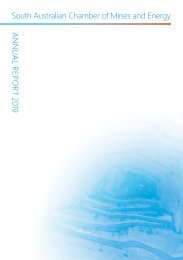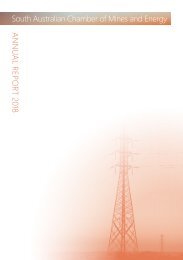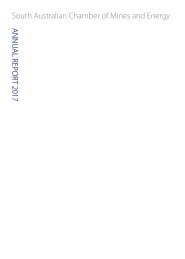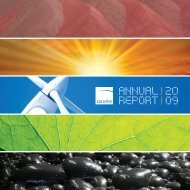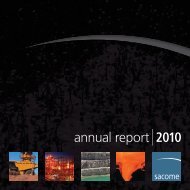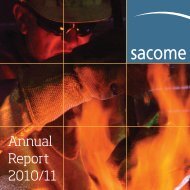SACOME Annual Report 2015-16
Create successful ePaper yourself
Turn your PDF publications into a flip-book with our unique Google optimized e-Paper software.
POLICY<br />
Nuclear Fuel Cycle Royal Commission<br />
<strong>SACOME</strong> played a significant role in the decision to hold a Royal<br />
Commission into the Nuclear Fuel Cycle through its surveys<br />
and analysis of attitudes to uranium and nuclear energy, which<br />
demonstrated that the public is ready for a mature discussion on this<br />
important topic.<br />
by providing a submission detailing hydraulic fracturing science<br />
and facts. <strong>SACOME</strong> presented to the committee in September <strong>2015</strong>,<br />
highlighting the misconceptions that have shaped the debate and<br />
emphasising that experience and monitoring have repeatedly shown<br />
no impacts that endorse the concerns. <strong>SACOME</strong> will again present to<br />
the committee when the final report is released in October 20<strong>16</strong>.<br />
Advocating for a mature debate into SA<br />
increasing its participation in the nuclear<br />
fuel cycle is a key <strong>SACOME</strong> position.<br />
The Nuclear Fuel Cycle Royal Commission (NFCRC) released four issues<br />
papers in July <strong>2015</strong> which <strong>SACOME</strong> responded to, also providing a<br />
submission to the Royal Commission’s tentative findings released in<br />
February 20<strong>16</strong>.<br />
<strong>SACOME</strong> Chief Executive Jason Kuchel<br />
visited New York state and Pennsylvania to<br />
understand fracking perceptions in these<br />
areas. He found community members<br />
nearby were not adverse, with objections<br />
to the technology largely from minorities in<br />
neighbouring cities.<br />
In the final NFCRC report released in May 20<strong>16</strong>, <strong>SACOME</strong> was pleased<br />
to see its recommendations for the reform of uranium mining<br />
approvals heeded, including the removal of impediments in the<br />
relevant State and Federal Acts.<br />
The Royal Commission agreed there is scope<br />
to expand the uranium mining industry<br />
in SA and we can be a major contributor to<br />
global emissions reductions through nuclear<br />
power.<br />
Fracking Inquiry<br />
In 2014 the Natural Resources Committee announced a parliamentary<br />
inquiry into the potential risks and impacts in the use of hydraulic<br />
fracture stimulation (fracking). <strong>SACOME</strong> responded to this inquiry<br />
Air Quality<br />
Early in 20<strong>16</strong>, the Environmental Protection Authority (EPA) released<br />
the draft Environmental Protection (Air Quality) Policy 20<strong>16</strong>. After the<br />
work that <strong>SACOME</strong> had undertaken on Air Quality policy in 2014-15,<br />
the Chamber was able to provide a comprehensive response to the<br />
draft policy. The area of particular concern was changes to Maximum<br />
Pollutant Levels (MPL) which would potentially add regulatory burden<br />
in the areas of monitoring, reporting, and independent verifications of<br />
particulate matter, specifically PM10 and PM2.5. .<br />
<strong>SACOME</strong>’s advocacy also resulted in changes to the MPL for stack<br />
emissions to take into consideration the actual impact (or lack of ) at<br />
receptor sites. In relation to particulate matter, <strong>SACOME</strong> emphasised<br />
the inappropriate application of the Ambient Air Quality National<br />
Environment Protection Measure (NEPM) to monitor and manage<br />
point source emissions. <strong>SACOME</strong> is continuing to work with the EPA<br />
and DSD to refine the policy and ensure guidelines are risk based, and<br />
NEPM standards not considered absolute.<br />
Native Vegetation<br />
The <strong>2015</strong>-<strong>16</strong> period saw a number of changes to the native vegetation<br />
framework in South Australia with the Department of Environment,<br />
Water & Natural Resources (DEWNR) in continual dialogue with<br />
<strong>SACOME</strong> on the redevelopment of legislation, regulations and<br />
policy associated with native vegetation. Among these was a review<br />
of policy and guides for Significant Environmental Benefits (SEBs).<br />
<strong>SACOME</strong> highlighted in its submission the need for policy flexibility to<br />
enable positive environmental outcomes, while facilitating resources<br />
sector growth, consistent with the SA Government’s economic and<br />
strategic priorities.<br />
<strong>SACOME</strong> also provided feedback on the draft Native Vegetation<br />
Regulations 20<strong>16</strong> (SA) and the Guide to the draft regulations, with a<br />
comprehensive submission developed in conjunction with <strong>SACOME</strong>’s<br />
Sustainable Development Committee.<br />
Nature Foundation SA<br />
<strong>SACOME</strong> emphasised the need for<br />
transparency in the allocations of money<br />
from the Native Vegetation Fund, as public<br />
reporting on the KPI’s of projects and their<br />
delivery is essential for industry confidence<br />
in the management of funds.<br />
12 South Australian Chamber of Mines and Energy<br />
<strong>Annual</strong> <strong>Report</strong> 20<strong>16</strong> 13






